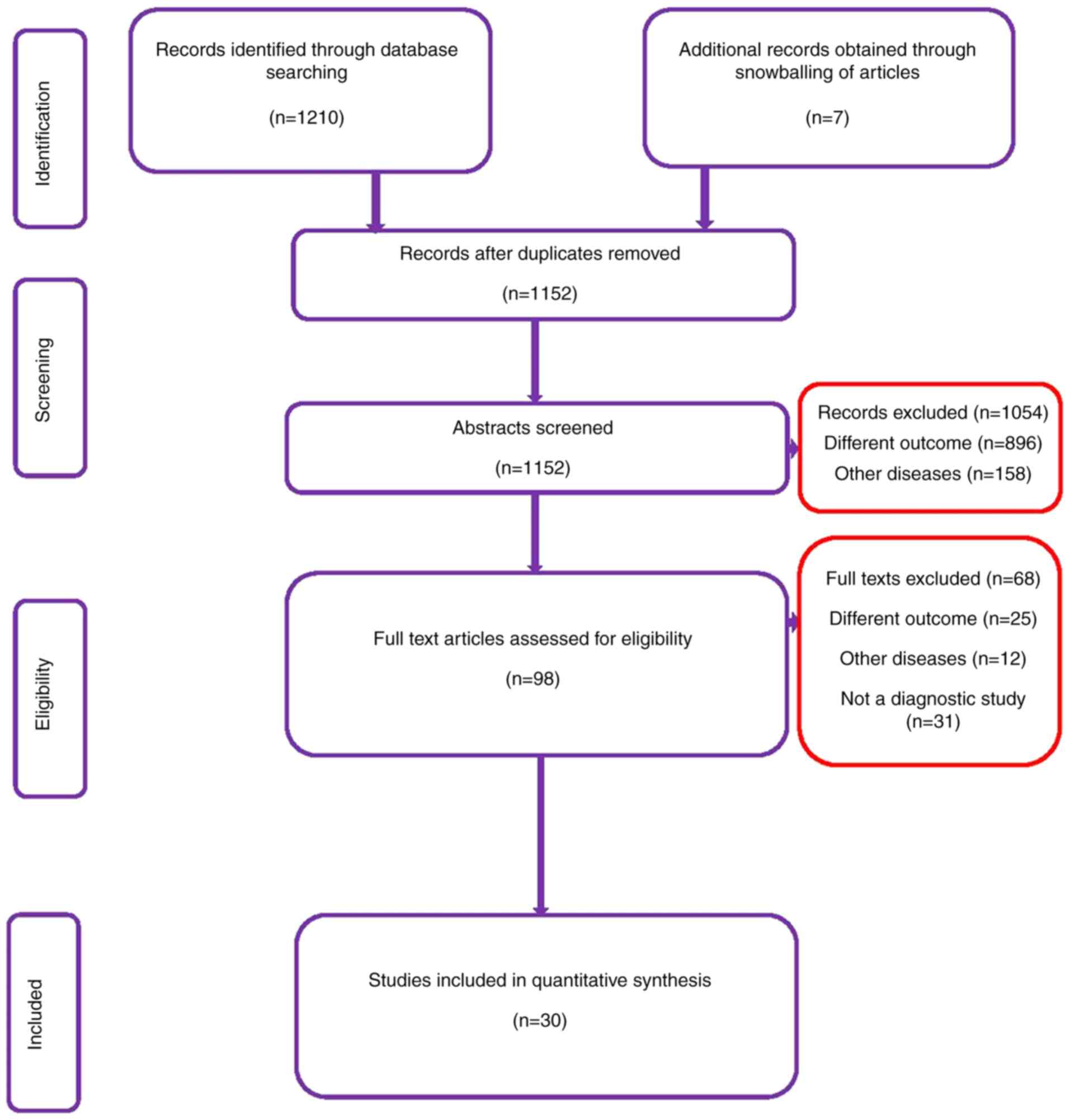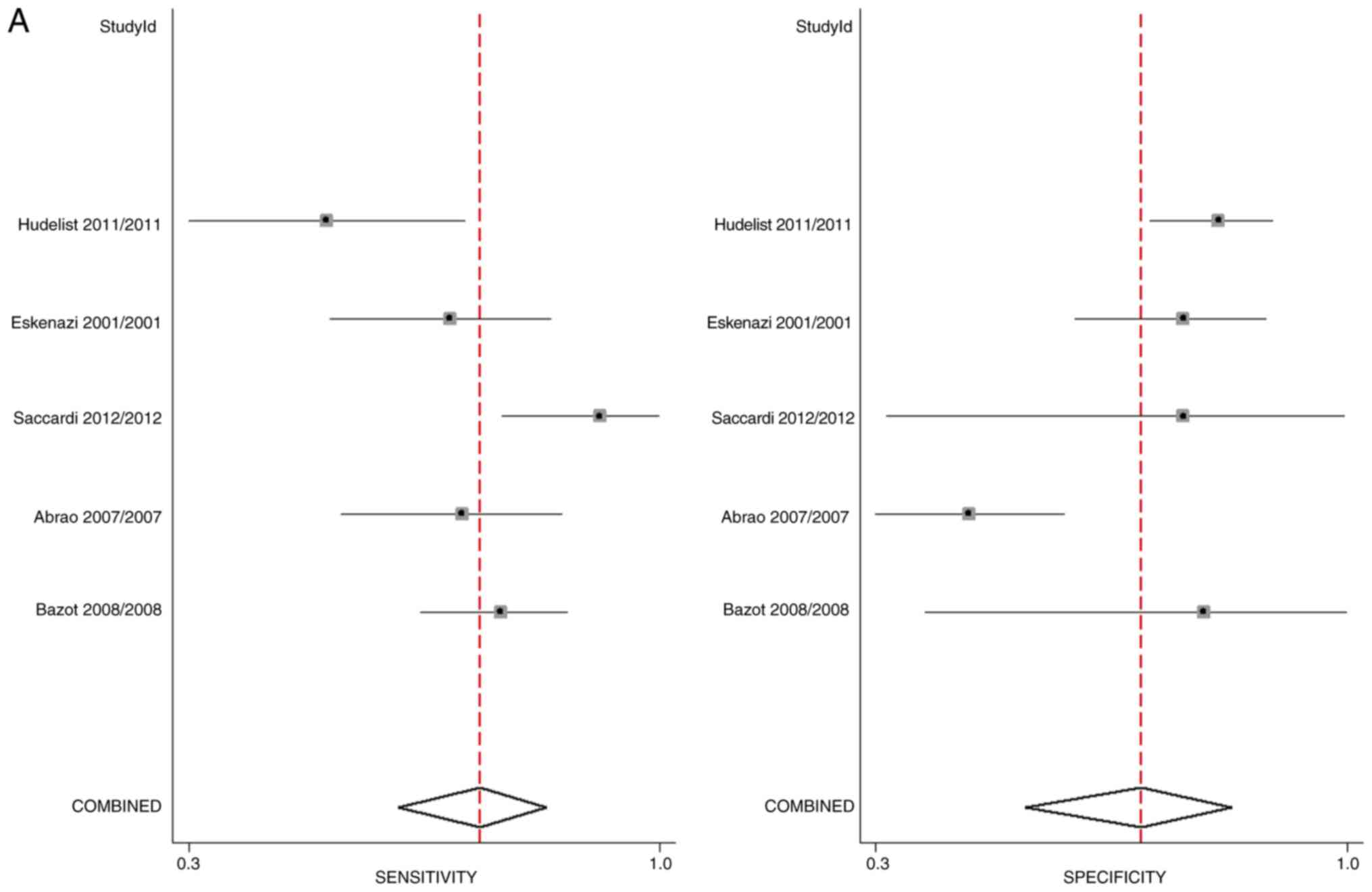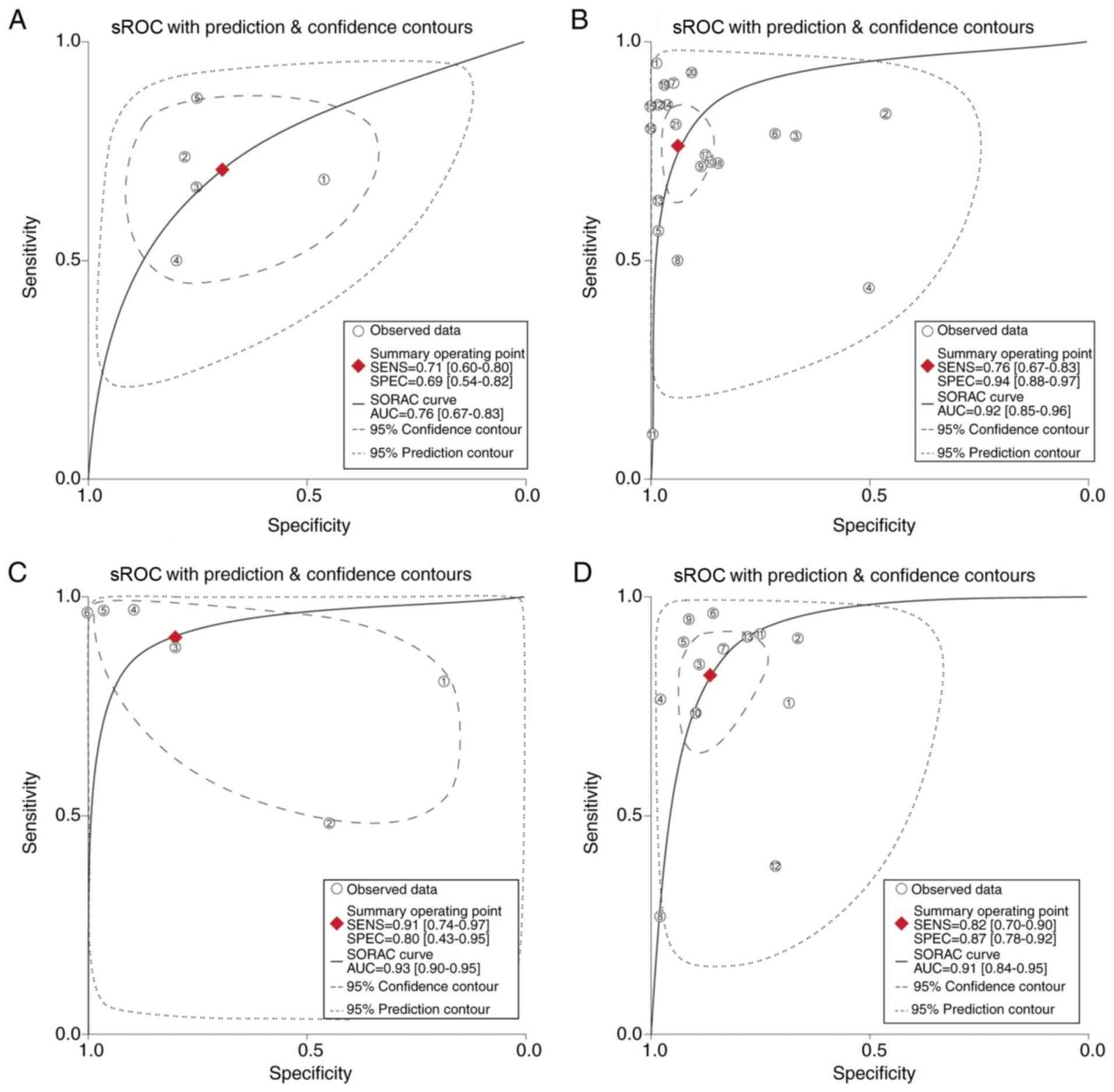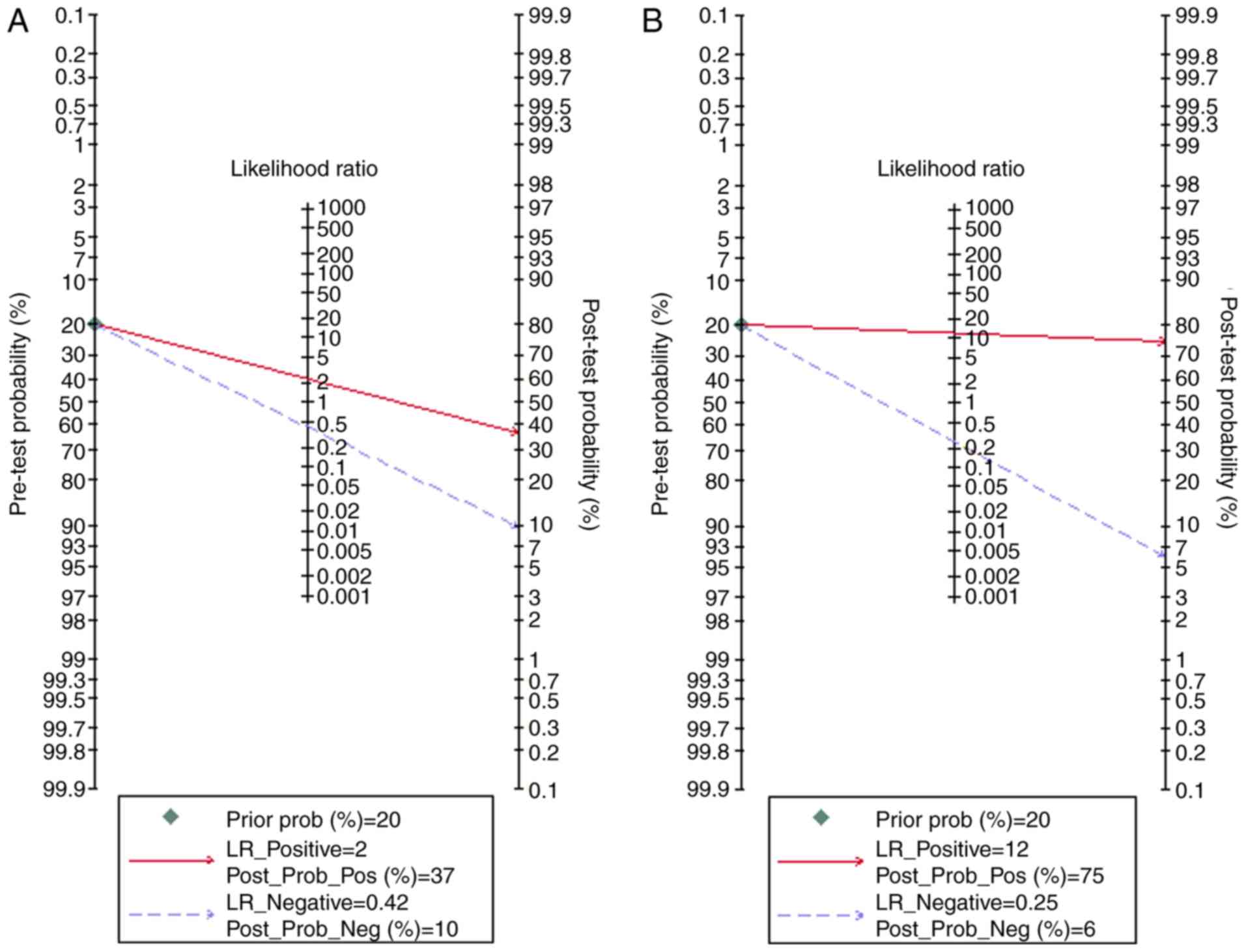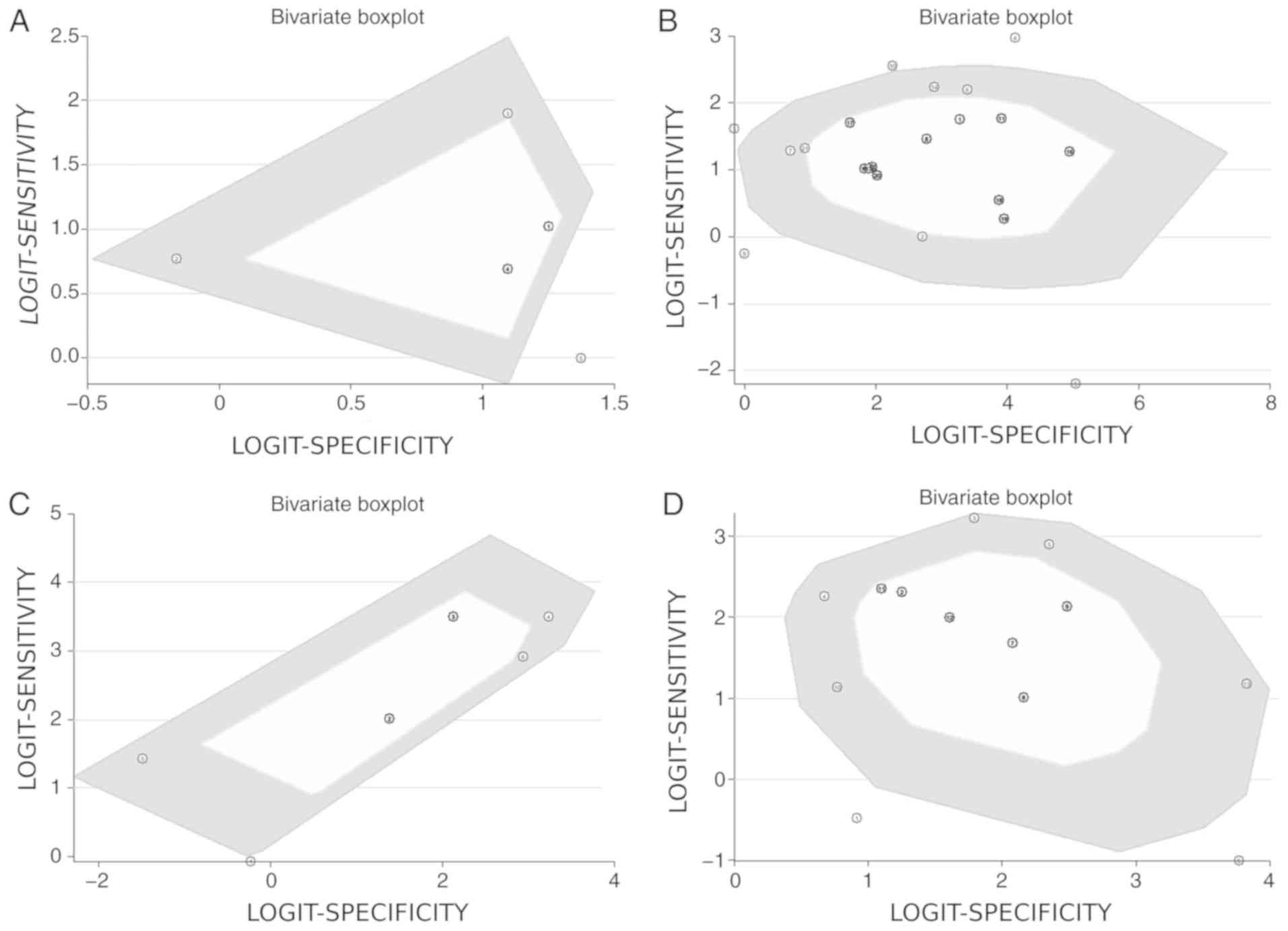|
1
|
Irving JA and Clement PB: Diseases of the
Peritoneum. In: Blaustein's Pathology of the Female Genital Tract.
Kurman RJ, Ellenson LH and Ronnett BM (eds) Springer US, Boston,
MA, pp625-678, 2011.
|
|
2
|
Wheeler JM: Epidemiology of
endometriosis-associated infertility. J Reprod Med. 34:41–46.
1989.PubMed/NCBI
|
|
3
|
Foti PV, Farina R, Palmucci S, Vizzini
IAA, Libertini N, Coronella M, Spadola S, Caltabiano R, Iraci M,
Basile A, et al: Endometriosis: Clinical features, MR imaging
findings and pathologic correlation. Insights Imaging. 9:149–172.
2018.PubMed/NCBI View Article : Google Scholar
|
|
4
|
Nisolle M and Donnez J: Peritoneal
endometriosis, ovarian endometriosis, and adenomyotic nodules of
the rectovaginal septum are three different entities. Fertil
Steril. 68:585–596. 1997.PubMed/NCBI View Article : Google Scholar
|
|
5
|
Cornillie FJ, Oosterlynck D, Lauweryns JM
and Koninckx PR: Deeply infiltrating pelvic endometriosis:
Histology and clinical significance. Fertil Steril. 53:978–983.
1990.PubMed/NCBI View Article : Google Scholar
|
|
6
|
Johnson NP and Hummelshoj L: World
Endometriosis Society Montpellier Consortium. Consensus on current
management of endometriosis. Hum Reprod. 28:1552–1568.
2013.PubMed/NCBI View Article : Google Scholar
|
|
7
|
Rafique S and Decherney AH: Medical
management of endometriosis. Clin Obstet Gynecol. 60:485–496.
2017.PubMed/NCBI View Article : Google Scholar
|
|
8
|
Guo SW: Recurrence of endometriosis and
its control. Hum Reprod Update. 15:441–461. 2009.PubMed/NCBI View Article : Google Scholar
|
|
9
|
Duffy JMN, Arambage K, Correa FJS, Olive
D, Farquhar C, Garry R, Barlow DH and Jacobson TZ: Laparoscopic
surgery for endometriosis. Cochrane Database Syst Rev.
3(CD011031)2014.PubMed/NCBI View Article : Google Scholar
|
|
10
|
Dmowski WP, Lesniewicz R, Rana N, Pepping
P and Noursalehi M: Changing trends in the diagnosis of
endometriosis: A comparative study of women with pelvic
endometriosis presenting with chronic pelvic pain or infertility.
Fertil Steril. 67:238–243. 1997.PubMed/NCBI View Article : Google Scholar
|
|
11
|
Nisenblat V, Bossuyt PMM, Farquhar C,
Johnson N and Hull ML: Imaging modalities for the non-invasive
diagnosis of endometriosis. Cochrane Database Syst Rev.
2(CD009591)2016.PubMed/NCBI View Article : Google Scholar
|
|
12
|
Whiting PF, Rutjes AWS, Westwood ME,
Mallett S, Deeks JJ, Reitsma JBR, Leeflang MMG, Sterne JAC and
Bossuyt PMM: QUADAS-2 Group. QUADAS-2: A revised tool for the
quality assessment of diagnostic accuracy studies. Ann Intern Med.
155:529–536. 2011.PubMed/NCBI View Article : Google Scholar
|
|
13
|
Pan B, Zhang X and Liu S: Evaluation of
the ROC analysis in SPSS in the test/diagnosis. Strait J Prev Med.
9(5)2003.
|
|
14
|
Higgins JPT, Altman DG and Sterne JAC
(eds): Chapter 8: Assessing risk of bias in included studies. In:
Higgins JPT, Churchill R, Chandler J, Cumpston MS (eds), Cochrane
Handbook for Systematic Reviews of Interventions version 5.2.0
(updated June 2017), Cochrane, 2017.
|
|
15
|
Abrao MS, Gonçalves MO, Dias JA Jr,
Podgaec S, Chamie LP and Blasbalg R: Comparison between clinical
examination, transvaginal sonography and magnetic resonance imaging
for the diagnosis of deep endometriosis. Hum Reprod. 22:3092–3097.
2007.PubMed/NCBI View Article : Google Scholar
|
|
16
|
Alborzi S, Rasekhi A, Shomali Z, Madadi G,
Alborzi M, Kazemi M and Hosseini Nohandani A: Diagnostic accuracy
of magnetic resonance imaging, transvaginal, and transrectal
ultrasonography in deep infiltrating endometriosis. Medicine
(Baltimore). 97(e9536)2018.PubMed/NCBI View Article : Google Scholar
|
|
17
|
Bazot M, Lafont C, Rouzier R, Roseau G,
Thomassin-Naggara I and Daraï E: Diagnostic accuracy of physical
examination, transvaginal sonography, rectal endoscopic sonography,
and magnetic resonance imaging to diagnose deep infiltrating
endometriosis. Fertil Steril. 92:1825–1833. 2009.PubMed/NCBI View Article : Google Scholar
|
|
18
|
Bergamini V, Ghezzi F, Scarperi S,
Raffaelli R, Cromi A and Franchi M: Preoperative assessment of
intestinal endometriosis: A comparison of transvaginal sonography
with water-contrast in the rectum, transrectal sonography, and
barium enema. Abdom Imaging. 35:732–736. 2010.PubMed/NCBI View Article : Google Scholar
|
|
19
|
Chapron C, Vieira M, Chopin N, Balleyguier
C, Barakat H, Dumontier I, Roseau G, Fauconnier A, Foulot H and
Dousset B: Accuracy of rectal endoscopic ultrasonography and
magnetic resonance imaging in the diagnosis of rectal involvement
for patients presenting with deeply infiltrating endometriosis.
Ultrasound Obstet Gynecol. 24:175–179. 2004.PubMed/NCBI View
Article : Google Scholar
|
|
20
|
Chamié LP, Blasbalg R, Gonçalves MOC,
Carvalho FM, Abrão MS and de Oliveira IS: Accuracy of magnetic
resonance imaging for diagnosis and preoperative assessment of
deeply infiltrating endometriosis. Int J Gynaecol Obstet.
106:198–201. 2009.PubMed/NCBI View Article : Google Scholar
|
|
21
|
Dessole S, Farina M, Rubattu G, Cosmi E,
Ambrosini G and Nardelli GB: Sonovaginography is a new technique
for assessing rectovaginal endometriosis. Fertil Steril.
79:1023–1027. 2003.PubMed/NCBI View Article : Google Scholar
|
|
22
|
Eskenazi B, Warner M, Bonsignore L, Olive
D, Samuels S and Vercellini P: Validation study of nonsurgical
diagnosis of endometriosis. Fertil Steril. 76:929–935.
2001.PubMed/NCBI View Article : Google Scholar
|
|
23
|
Fedele L, Bianchi S, Portuese A, Borruto F
and Dorta M: Transrectal ultrasonography in the assessment of
rectovaginal endometriosis. Obstet Gynecol. 91:444–448.
1998.PubMed/NCBI View Article : Google Scholar
|
|
24
|
Grasso RF, Di Giacomo V, Sedati P, Sizzi
O, Florio G, Faiella E, Rossetti A, Vescovo RD and Zobel BB:
Diagnosis of deep infiltrating endometriosis: accuracy of magnetic
resonance imaging and transvaginal 3D ultrasonography. Abdom
Imaging. 35:716–725. 2010.PubMed/NCBI View Article : Google Scholar
|
|
25
|
Guerriero S, Ajossa S, Gerada M, D'Aquila
M, Piras B and Melis GB: ‘Tenderness-guided’ transvaginal
ultrasonography: A new method for the detection of deep
endometriosis in patients with chronic pelvic pain. Fertil Steril.
88:1293–1297. 2007.PubMed/NCBI View Article : Google Scholar
|
|
26
|
Guerriero S, Ajossa S, Gerada M, Virgilio
B, Angioni S and Melis GB: Diagnostic value of transvaginal
‘tenderness-guided’ ultrasonography for the prediction of location
of deep endometriosis. Hum Reprod. 23:2452–2457. 2008.PubMed/NCBI View Article : Google Scholar
|
|
27
|
Guerriero S, Saba L, Ajossa S, Peddes C,
Angiolucci M, Perniciano M, Melis GB and Alcázar JL:
Three-dimensional ultrasonography in the diagnosis of deep
endometriosis. Hum Reprod. 29:1189–1198. 2014.PubMed/NCBI View Article : Google Scholar
|
|
28
|
Guerriero S, Alcázar JL, Pascual MA,
Ajossa S, Perniciano M, Piras A, Mais V, Piras B, Schirru F,
Benedetto MG and Saba L: Deep infiltrating endometriosis:
Comparison between 2-dimensional ultrasonography (US),
3-dimensional US, and magnetic resonance imaging. J Ultrasound Med.
37:1511–1521. 2018.PubMed/NCBI View Article : Google Scholar
|
|
29
|
Ha HK, Lim YT, Kim HS, Suh TS, Song HH and
Kim SJ: Diagnosis of pelvic endometriosis: fat-suppressed
T1-weighted vs conventional MR images. AJR Am J Roentgenol.
163:127–131. 1994.PubMed/NCBI View Article : Google Scholar
|
|
30
|
Holland TK, Yazbek J, Cutner A, Saridogan
E, Hoo WL and Jurkovic D: Value of transvaginal ultrasound in
assessing severity of pelvic endometriosis. Ultrasound Obstet
Gynecol. 36:241–248. 2010.PubMed/NCBI View
Article : Google Scholar
|
|
31
|
Holland TK, Cutner A, Saridogan E,
Mavrelos D, Pateman K and Jurkovic D: Ultrasound mapping of pelvic
endometriosis: Does the location and number of lesions affect the
diagnostic accuracy? A multicentre diagnostic accuracy study. BMC
Womens Health. 13(43)2013.PubMed/NCBI View Article : Google Scholar
|
|
32
|
Hudelist G, Ballard K, English J, Wright
J, Banerjee S, Mastoroudes H, Thomas A, Singer CF and Keckstein J:
Transvaginal sonography vs. clinical examination in the
preoperative diagnosis of deep infiltrating endometriosis.
Ultrasound Obstet Gynecol. 37:480–487. 2011.PubMed/NCBI View
Article : Google Scholar
|
|
33
|
Hudelist G, Fritzer N, Staettner S, Tammaa
A, Tinelli A, Sparic R and Keckstein J: Uterine sliding sign: A
simple sonographic predictor for presence of deep infiltrating
endometriosis of the rectum. Ultrasound Obstet Gynecol. 41:692–695.
2013.PubMed/NCBI View Article : Google Scholar
|
|
34
|
Manganaro L, Vinci V, Bernardo S and
Storelli P: The role of 3.0T MRI in the assessment of deep
endometriosis located on the uterosacral ligaments. J Endo.
5:10–16. 2013.
|
|
35
|
Piessens S, Healey M, Maher P, Tsaltas J
and Rombauts L: Can anyone screen for deep infiltrating
endometriosis with transvaginal ultrasound? Aust N Z J Obstet
Gynaecol. 54:462–468. 2014.PubMed/NCBI View Article : Google Scholar
|
|
36
|
Ribeiro HSAA, Ribeiro PA, Rossini L,
Rodrigues FC, Donadio N and Aoki T: Double-contrast barium enema
and transrectal endoscopic ultrasonography in the diagnosis of
intestinal deeply infiltrating endometriosis. J Minim Invasive
Gynecol. 15:315–320. 2008.PubMed/NCBI View Article : Google Scholar
|
|
37
|
Saba L, Guerriero S, Sulis R, Pilloni M,
Ajossa S, Melis G and Mallarini G: Learning curve in the detection
of ovarian and deep endometriosis by using magnetic resonance:
Comparison with surgical results. Eur J Radiol. 79:237–244.
2011.PubMed/NCBI View Article : Google Scholar
|
|
38
|
Saccardi C, Cosmi E, Borghero A, Tregnaghi
A, Dessole S and Litta P: Comparison between transvaginal
sonography, saline contrast sonovaginography and magnetic resonance
imaging in the diagnosis of posterior deep infiltrating
endometriosis. Ultrasound Obstet Gynecol. 40:464–469.
2012.PubMed/NCBI View Article : Google Scholar
|
|
39
|
Savelli L, Manuzzi L, Coe M, Mabrouk M, Di
Donato N, Venturoli S and Seracchioli R: Comparison of transvaginal
sonography and double-contrast barium enema for diagnosing deep
infiltrating endometriosis of the posterior compartment. Ultrasound
Obstet Gynecol. 38:466–471. 2011.PubMed/NCBI View
Article : Google Scholar
|
|
40
|
Stratton P, Winkel C, Premkumar A, Chow C,
Wilson J, Hearns-Stokes R, Heo S, Merino M and Nieman LK:
Diagnostic accuracy of laparoscopy, magnetic resonance imaging, and
histopathologic examination for the detection of endometriosis.
Fertil Steril. 79:1078–1085. 2003.PubMed/NCBI View Article : Google Scholar
|
|
41
|
Takeuchi H, Kuwatsuru R, Kitade M, Sakurai
A, Kikuchi I, Shimanuki H and Kinoshita K: A novel technique using
magnetic resonance imaging jelly for evaluation of rectovaginal
endometriosis. Fertil Steril. 83:442–447. 2005.PubMed/NCBI View Article : Google Scholar
|
|
42
|
Ubaldi F, Wisanto A, Camus M, Tournaye H,
Clasen K and Devroey P: The role of transvaginal ultrasonography in
the detection of pelvic pathologies in the infertility workup. Hum
Reprod. 13:330–333. 1998.PubMed/NCBI View Article : Google Scholar
|
|
43
|
Valenzano Menada M, Remorgida V, Abbamonte
LH, Nicoletti A, Ragni N and Ferrero S: Does transvaginal
ultrasonography combined with water-contrast in the rectum aid in
the diagnosis of rectovaginal endometriosis infiltrating the bowel?
Hum Reprod. 23:1069–1075. 2008.PubMed/NCBI View Article : Google Scholar
|
|
44
|
Vimercati A, Achilarre MT, Scardapane A,
Lorusso F, Ceci O, Mangiatordi G, Angelelli G, Van Herendael B,
Selvaggi L and Bettocchi S: Accuracy of transvaginal sonography and
contrast-enhanced magnetic resonance-colonography for the
presurgical staging of deep infiltrating endometriosis. Ultrasound
Obstet Gynecol. 40:592–603. 2012.PubMed/NCBI View Article : Google Scholar
|
|
45
|
James FN and Umar S: 2016. The World
Bank's classification of countries by income (English). Policy
Research working paper; no. WPS 7528. Washington, DC: World Bank
Group. Available from: http://documents.worldbank.org/curated/en/408581467988942234/The-World-Banks-classification-of-countries-by-income.
|
|
46
|
Moura APC, Ribeiro HSAA, Bernardo WM,
Simões R, Torres US, D'Ippolito G, Bazot M and Ribeiro PA: Accuracy
of transvaginal sonography versus magnetic resonance imaging in the
diagnosis of rectosigmoid endometriosis: Systematic review and
meta-analysis. PLoS One. 14(e0214842)2019.PubMed/NCBI View Article : Google Scholar
|
|
47
|
Guerriero S, Saba L, Pascual MA, Ajossa S,
Rodriguez I, Mais V and Alcazar JL: Transvaginal ultrasound vs
magnetic resonance imaging for diagnosing deep infiltrating
endometriosis: Systematic review and meta-analysis. Ultrasound
Obstet Gynecol. 51:586–595. 2018.PubMed/NCBI View Article : Google Scholar
|
|
48
|
Guerriero S, Ajossa S, Orozco R,
Perniciano M, Jurado M, Melis GB and Alcazar JL: Accuracy of
transvaginal ultrasound for diagnosis of deep endometriosis in the
rectosigmoid: Systematic review and meta-analysis. Ultrasound
Obstet Gynecol. 47:281–289. 2016.PubMed/NCBI View Article : Google Scholar
|
|
49
|
Šikic Z: Rules of thumb for positive and
negative test results. J Eval Clin Pract. 28(1111)2020.PubMed/NCBI View Article : Google Scholar
|
|
50
|
Practice Bulletin no. 114: Management of
endometriosis. Obstet Gynecol. 116:223–236. 2010.PubMed/NCBI View Article : Google Scholar
|
|
51
|
Dunselman GAJ, Vermeulen N, Becker C,
Calhaz-Jorge C, D'Hooghe T, Bie BD, Heikinheimo O, Horne AW, Kiesel
L, Nap A, et al: ESHRE guideline: Management of women with
endometriosis. Hum Reprod. 29:400–412. 2014.PubMed/NCBI View Article : Google Scholar
|















